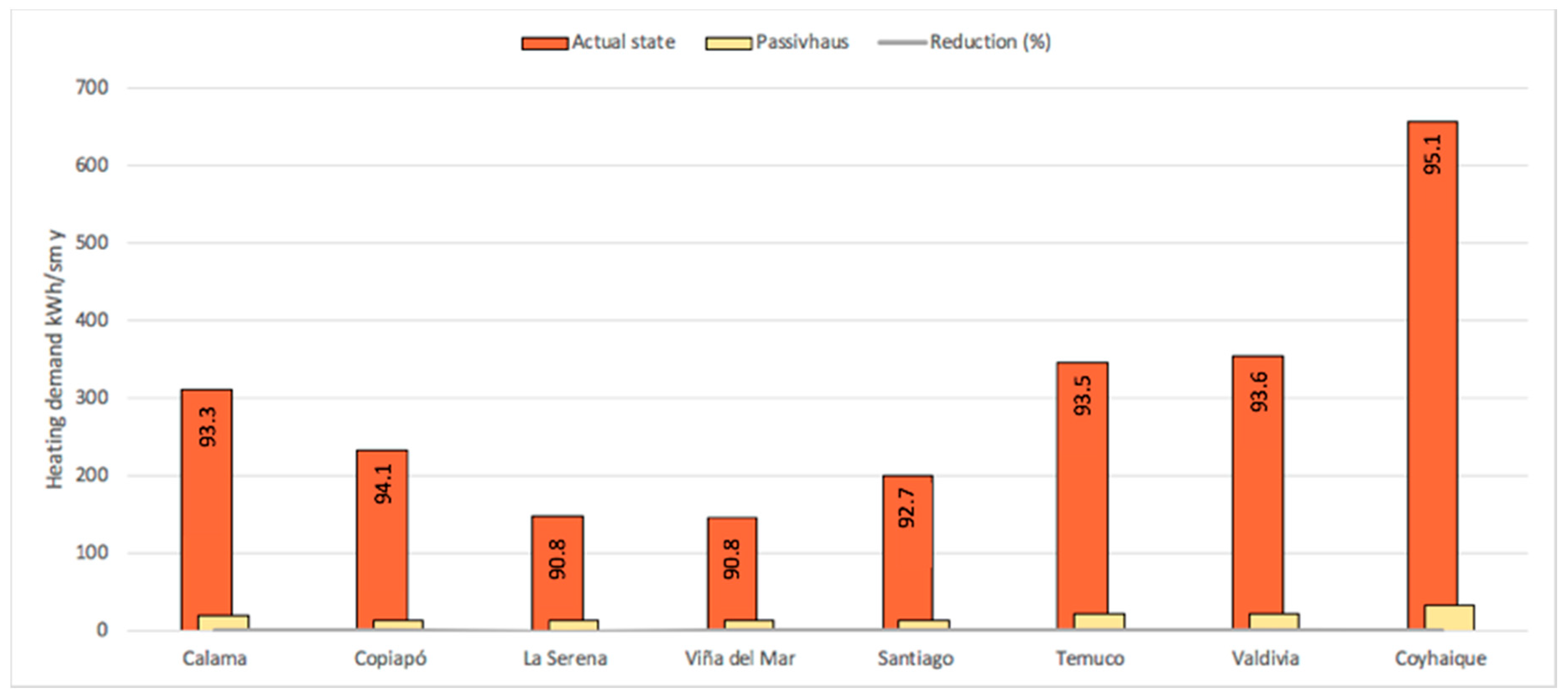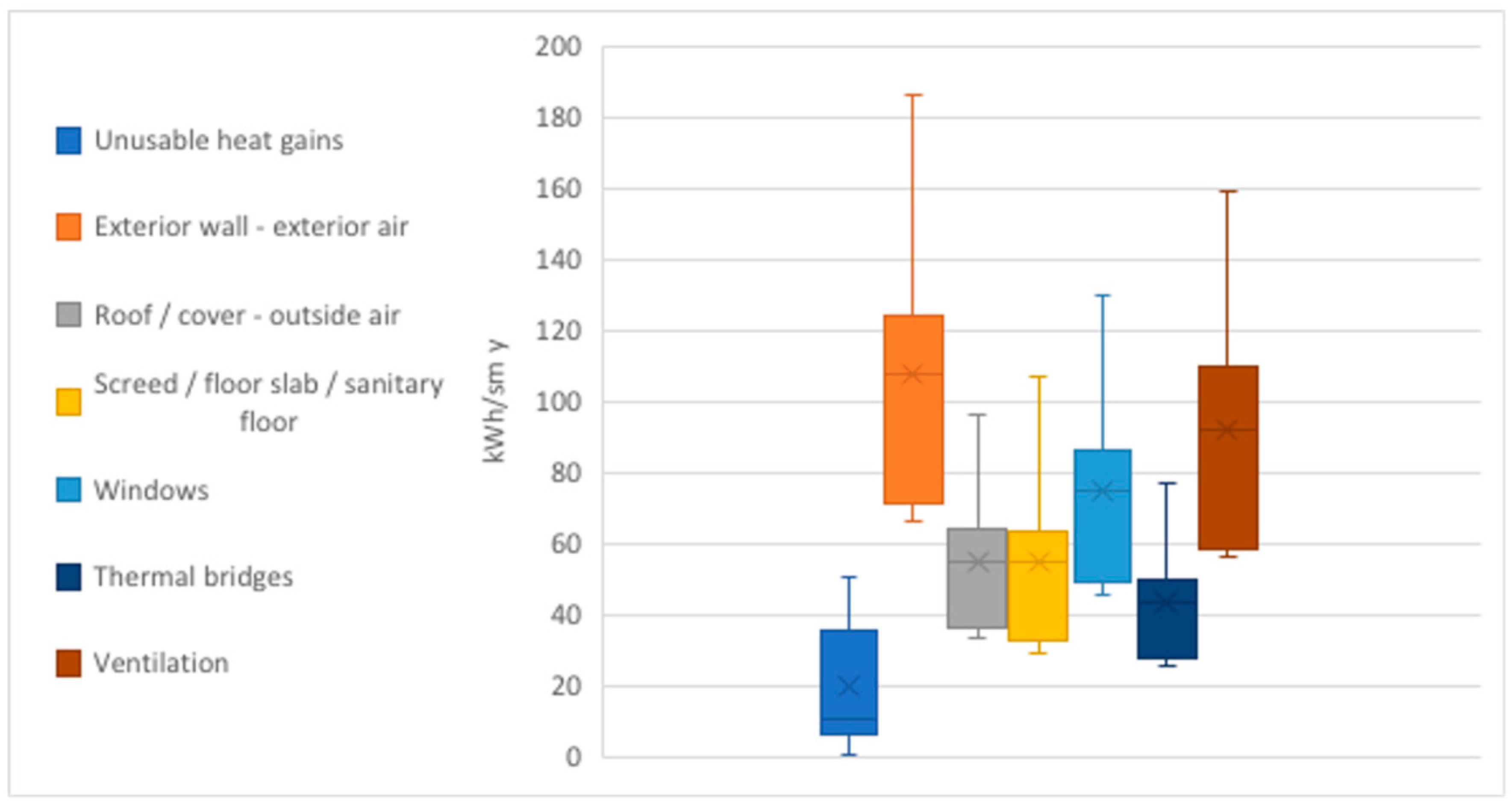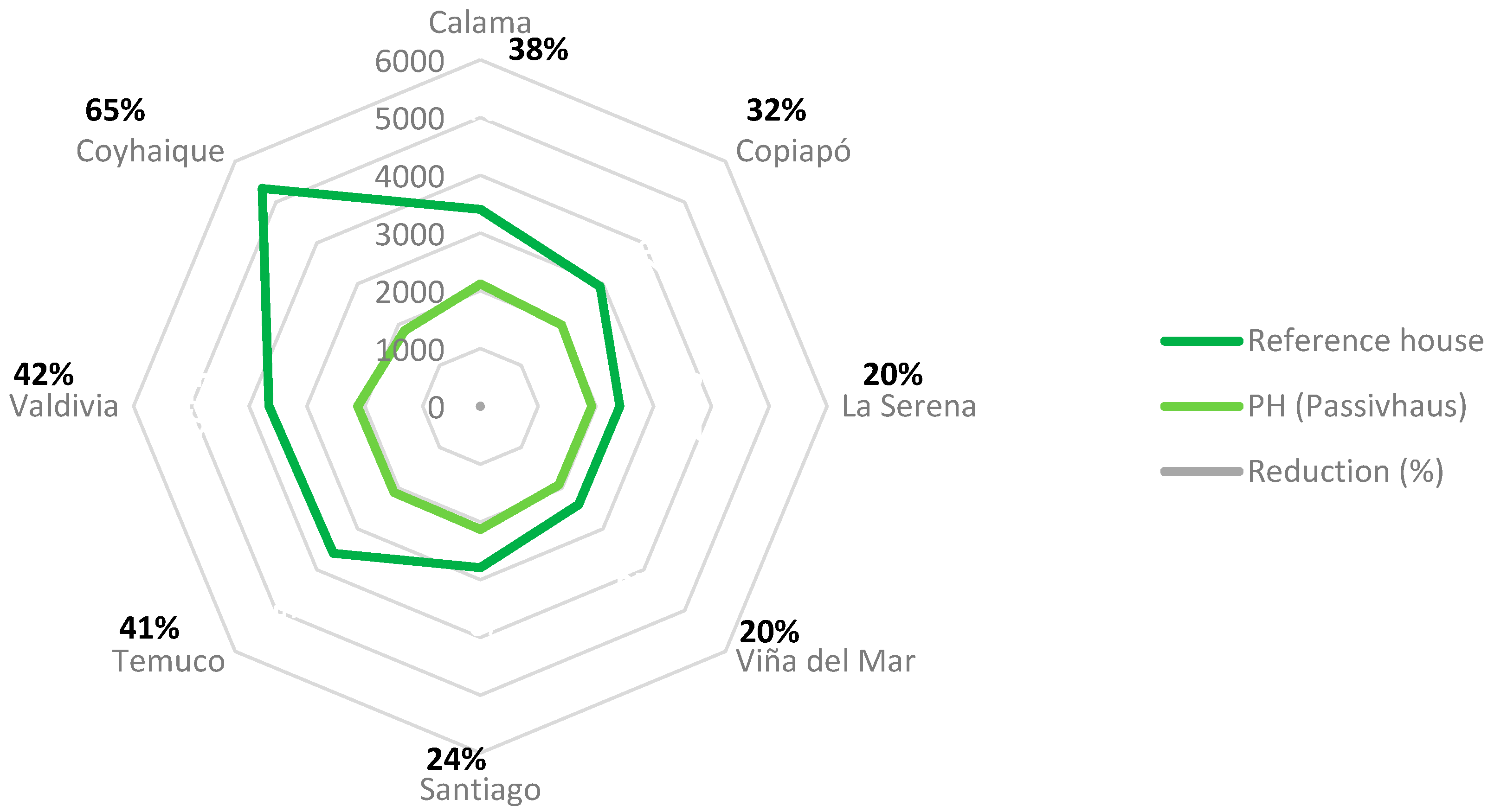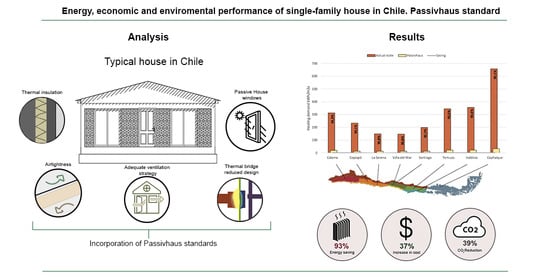1. Introduction
The human influence on climate conditions is evident, resulting in anthropogenic greenhouse gas emissions reaching their highest recorded values in history.
Greenhouse gas emission projections vary greatly depending on both the level of socioeconomic development and the climate policies implemented in each country [
1].
The construction sector is responsible for over one-third of the total global energy consumption and almost 40% of the total CO
2 emissions (both direct and indirect). Furthermore, the energy demand of buildings and building construction is on the rise due to countries having improved access to energy, both increased ownership and use of electronic devices, and the fast growth of the construction sector [
2,
3].
The energy used for heating, refrigeration, domestic hot water, and lighting represents the highest total energy percentage in the different stages of a building’s lifespan, being collectively responsible for 22% of the total global energy consumption and approximately 13% of global GHG emissions [
4]. This type of consumption typically ranks first as the largest source of CO
2 emissions, surpassing the energy necessary to extract and manufacture materials, and even the energy necessary for the construction of buildings [
5]. Residential buildings are responsible for two-thirds of emissions of this type. Incidentally, these buildings have the highest potential for energy savings [
6].
The importance of the construction sector in Chile is evident. This sector is responsible for 26% of the total energy use, 34% of solid waste production, 33% of GHG emissions, and 6% of water use [
7]. Furthermore, residential construction in Chile accounts for a quarter of the total energy consumption [
8]. In the future, buildings must be more energy efficient in order to address the issue of excessive energy consumption and reduce these figures [
9].
Worldwide, there are voluntary environmental certifications and building standards that can be adopted by the construction sector toward mitigating the negative effects of climate change. These certifications and standards go one step further than the national building regulations. Environmental certifications are designed to quantify and control sustainability indexes in construction through different ISO (International Organization for Standardization) regulations. The LEED (Leadership in Energy and Environmental Design)—developed by the U.S. green building council (USGBC), in line with American regulations—is the most well-known ISO regulation. A LEED-certified building does not necessarily use less energy than a building without this certification, which consequently leaves the energy consumption issue unresolved. Moreover, it has been found that the energy performance measured in LEED buildings has little correlation to the building’s certification level or the number of energy credits the building has achieved in the design stage [
9,
10].
From a regulatory point of view, although Chile has a thermal regulation policy [
11] that regulates the requirements for the envelope, restricting the transmittance values in ventilated walls, ceilings, and floors, there is no regulatory reference aimed at reducing the demand for energy or regarding the airtightness of a house. Similarly, Brazil—a country that has regulations that are mainly oriented toward the levels of transmittance of certain elements from the envelope—is comparable to Chile in that it has not implemented regulations that establish requirements regarding energy demand levels [
12]. Concurrently, the thermal transmittance values of an enclosure are regulated in Chile while taking into consideration its climatic and performance similarities with other European countries, such as the United Kingdom or Spain. Additionally, when considering levels of hermeticity, establishing a limit on the energy demand may still be insufficient [
13,
14,
15,
16,
17], as is the case in countries such as Sweden and Portugal, where the imposition of regulations on the transmittance levels of the envelope—as in the previous examples—failed to substantially reduce the energy demand of the dwellings [
12,
18]. As a policy to mitigate these gaps, the European Union, through its Directive 2010/31/EU, stipulates that from the year 2021, houses should be built with near-zero energy consumption restrictions in place [
19]. On the other hand, building standards focus on controlling issues that are very influential with regard to sustainability, such as energy use and consumption during a building’s lifespan. Passivhaus (PH) is the best known international standard, as its required energy efficiency is higher than that of any other comparable standard [
20]. It was developed in Germany in the late 1980s by Wolfgang Feist and Bo Adamson. PH ensures a comfortable indoor climate in the summer and winter without a conventional heating distribution system. In this way, the energy required for heating is reduced by approximately 80%, and the general primary energy consumption is reduced by 50% (including utilities and electric appliances). To meet these targets, the building’s heating load must not exceed 10 W/m
2 [
21,
22], which can be achieved by an additional 5–10% [
23,
24] cost expenditure.
The adoption of PH in Chile is relatively recent. The first PH-certified building was built in 2010 [
25]. Additionally, two more buildings in Chile are recognized by the Passive House Institute (PHI), though without certification [
26].
Regardless of the Chilean regulation, different studies identify Passivhaus as an aggressive and demanding standard [
27], and it has even been considered the most aggressive in the world [
28]. To achieve this standard, extra effort must be made, as in the Australian case, where the use of Passivhaus as a design tool allowed the design team to overcome limitations of the Australian building code [
29]. Therefore, it is necessary to evaluate different strategies according to the climate in order to achieve PH. In tropical climates, the main strategy entails cooling and dehumidification [
30]; in China, the use of an mechanical ventilation with heat recovery (MVHR) system is essential [
31], and for all types of climates in Germany, Romania, and Ukraine, energy demand increases as latitude increases, so this strategy aims to increase insulation levels based on location [
32]. On the other hand, studies show that to achieve PH, it is necessary to place special emphasis on summer overheating and on shading strategies to achieve thermal comfort [
33].
Given the outlined context, this study suggests incorporating the PH standard for housing in Chile through the addition of building construction improvements for housing situated across the country and reflecting various climates. Likewise, it evaluates whether or not PH is a good strategy at the national level in terms of energy savings, necessary investments, and environmental externalities. At the same time, the goal is to promote a concrete methodology to fight climate change. For this purpose, the 9.6a version of the energy balance tool Passive House Planning Package (PHPP) was used [
34]. As a part of the certification process, it is mandatory that each PH housing development be modeled and verified with PHPP [
35].
4. Discussion
When assessing the reference housing in terms of energy, none of the eight studied cities comply with PH requirements. Heating energy demand varies from 147.3 to 657.9 kWh/m
2 per year, far from the required standard of 15 kWh/m
2 per year. This difference occurs due to the current building regulations in Chile, which, as studies indicate, display significant disparities regarding key concepts that directly affect a building’s energy performance. Infiltration is one of the essential unsolved concepts in Chilean regulation. In Chile, the average infiltration index is 12.9 air changes per hour [
7], in contrast with the 3 air changes per hour required in most European countries and the 0.6 air changes per hour required by PH. The air changes per hour identified for the housing under study are 19 times greater than those contemplated by PH.
As with infiltrations, most of Chile’s housing has deficient thermal envelope elements since the vast majority was built before the implementation of the regulations in 2000, and another significant percentage was built between 2007 and 2013, which resulted in elements of glazed and non-glazed areas being inferior to those required by PH.
This study identified a thermal transmittance U value for walls nine times higher than PH requirements, a window U value six times higher, and a roof U value five times higher than that identified in international studies [
22,
57]. Flooring in Chile is not the subject of thermal restrictions.
The significant differences noted in each of the thermal envelope elements and the infiltration levels are responsible for Chile’s excessive housing energy demand.
On the financial side, international studies acknowledge that the additional contribution of incorporating the PH standard fluctuates between an additional 8% to 15% [
23,
24]. On the other hand, in Chile, the incorporation of the PH standard would increase by an average of 37%. The reason for this difference is similar to the one found regarding energy. In European countries where price fluctuations are not significant, regulations control aspects that are not regulated in Chile and, therefore, the price per square meter is higher. Consequently, the additional contribution for compliance with PH is lower.
Regarding investment turnover, the country average is 11 years when considering energy savings and fuel inflation.
On the environmental side, incorporating the PH standard allows for a countrywide decrease of 93% in heating energy demand, which is in accordance with the experience internationally [
22,
24].
5. Conclusions
The Passivhaus standard refers to a building type designed to take advantage of the climate context in each specific zone. Theoretically, its incorporation is viable in any climate type, being more feasible in certain climates depending on a country’s economic and regulatory contexts.
In Chile’s case, the housing under study is well above the required PH values regardless of the climate zone. No overheating was identified in terms of refrigeration demand for the housing typology in the assessed climate conditions. Therefore, there is no need to incorporate active elements to cool the building in any season. This is due to the controlled ventilation machine with heat recovery (considered a passive element in this study) which conditions the air (both hot and cold). In Santiago’s case, a bypass system is necessary for the summer to prevent the ventilation machine from overheating.
When implementing the PH standard, special caution is needed to not overinsulate areas with high solar radiation as this may cause overheating of the house, generating discomfort in the summer. This, in turn, would result in noncompliance with the standard’s requirements.
On the other hand, the incorporated strategies and technologies go hand-in-hand with excellent execution. As this standard has minimal energy demands, the smallest error in execution will result in unnecessary energy loss, which may pass in a regular building, but could result in noncompliance with PH criteria in housing with these characteristics.
It was only possible to achieve the PH standard in each analyzed climate by incorporating passive elements, which are considered the pillars of this standard. This study focuses on the exclusive implementation of passive elements. However, it is necessary to consider each case to evaluate if it is more convenient (and, most of the time, it is) to incorporate active auxiliary systems that contribute to indoor comfort.
Furthermore, applying PH to the Chilean context promotes a reduction in GHG emissions, which aligns with Chile’s goals for 2030.
It was shown that the PH standard is feasible for Chilean climates at a high cost (compared to other international contexts). However, it can be amortized within a reasonable period given that a building’s lifespan is at least 50 years. The energy strategies result in energy cost reductions and offer residents spaces of higher quality with more stable and controlled levels of thermal comfort.
Finally, this study also demonstrates the feasibility of implementing Passivhaus in the different climatic zones of Chile with the current construction systems that are in place throughout the country. However, it is necessary to continue exploring thermo-modernization solutions through parametric studies and by training workers who can execute them correctly in order to meet the design requirements.



















